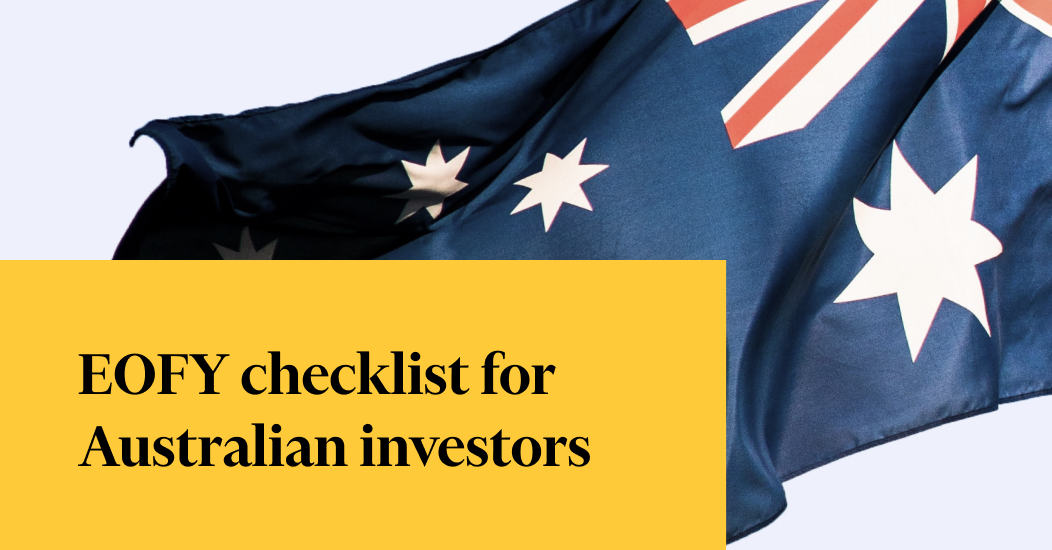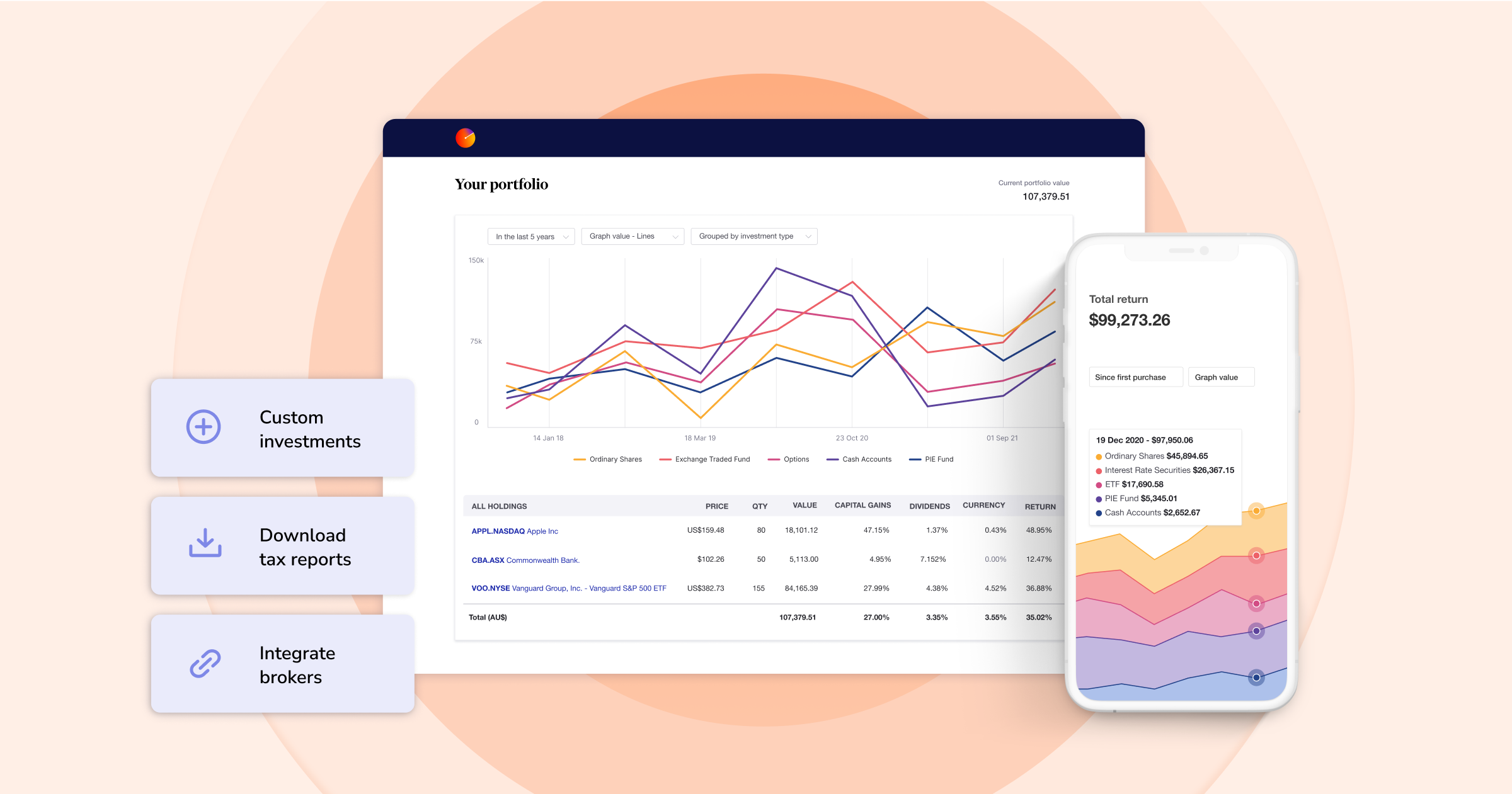EOFY checklist for Australian investors
Disclaimer: This article is for informational purposes only and does not constitute a specific product recommendation, or taxation or financial advice and should not be relied upon as such. While we use reasonable endeavours to keep the information up-to-date, we make no representation that any information is accurate or up-to-date. If you choose to make use of the content in this article, you do so at your own risk. To the extent permitted by law, we do not assume any responsibility or liability arising from or connected with your use or reliance on the content on our site. Please check with your adviser or accountant to obtain the correct advice for your situation.
With the Australian financial year rapidly drawing to a close, the month of June presents one last opportunity to get on top of your investments and understand what the tax implications are — before it’s too late.
For tax purposes, each financial year is seen as a snapshot in time used to assess the tax payable by individual Australians. Because of this, the timing of when investment income is earned, or when you realise capital gains, has important tax implications.
Are you a prepared for tax time? If not, don't stress — this article will go through all the important information you need to know to make the most of your time before the end of the financial year.

Take stock of your stocks (and unlisted investments)
First, you need to find out what investments you own, and the number of shares/units you own in each.
You could turn to your broker or fund manager for this information, and if you only own investments through a single entity that makes it easy. But for investors who trade across multiple brokers, or who also own unlisted investments, it’s best to consult Australia’s share registries (Link Market Services, Computershare and Boardroom being the most common) for records of the investments you own.
Once you have this information, you’ll need to put it together in one place. While some investors build a spreadsheet to do this, it is much easier to use Sharesight to track all your investments in a single place. If you don’t have a Sharesight account, take a second to sign up for a free account before finishing this article.
Paint your financial picture
Once you’re tracking all your investments in one place, you will need to establish the income and capital gains made on your investments during the current financial year.
Share dividend and fund distributions are a good place to start. Records of the income you received during the financial year can be found by running Sharesight’s taxable income report. Once you have this information, you can easily calculate your total income from dividends and distributions.
The taxable income report breaks down taxable income into local income (trust and non-trust) and foreign income.
Have you sold investments this financial year? If so, there will likely be capital gains tax implications. To calculate the capital gains tax on the sale of a parcel of shares, you’ll need to find out the cost price of the shares sold, and the sale price/quantity sold in any trades you made during the financial year. You can find this information from the broker or fund manager you used to make the trades.
It’s also important to note that Australia permits multiple methods to calculate capital gains tax on shares. Using different sale allocation methods such as first-in-first-out, highest-in-first-out and last-in-first-out can impact the cost price of the shares sold (and thus the capital gain made) if multiple parcels of shares were purchased throughout the financial year at different prices.
Fortunately, Sharesight’s capital gains tax report makes it easy to calculate capital gains and losses on investments sold during the year. Built to ATO rules, the capital gains tax report allows investors to calculate the optimum sale allocation method for each holding sold for their individual tax position.
While optimising the choice of sale allocation methods is critical to not pay more capital gains tax than is required, at this point, knowing the size of your realised capital gains or losses during the financial year will let you make the most of the time left before EOFY.
Put yourself in the best tax position
Now that you’ve got the full picture of your investments, do you know how your investments have performed? If you’ve made large capital gains during the year, there could be an opportunity to engage in tax loss selling strategies before 30 June to minimise your taxable income.
Tax loss selling is a strategy that involves selling an investment at a loss to offset a capital gains tax liability during the financial year. It’s a strategy you can use year-round, but is particularly useful in the lead-up to EOFY, when you have a better picture of your capital gains or losses for the year.
Tax loss selling example — Australian shares
An investor has recorded large capital gains during the year, but still holds Mesoblast (ASX: MSB) shares in their portfolio, purchased in 2021 at $1.87 per share. With Mesoblast shares now valued at $1.16, the investor can sell their Mesoblast shares during this financial year to realise the capital loss and offset the earlier gains from other sold shares.
Sharesight’s unrealised capital gains tax report makes it easy to model potential tax loss selling opportunities like the above in your portfolio. The report allows you to choose from a range of different sale allocation methods, with the results broken down into short and long-term capital gains (which incur different CGT discounts), as well as unrealised capital losses.
The unrealised CGT report helps investors make the most of tax loss selling.
Tax loss selling is within the ATO rules, but you must keep in mind that the ATO seeks to prevent abuse of this strategy, and does not look favourably on wash sales. This is where an investor sells shares right before EOFY to incur a tax loss, then repurchases shares in the same asset for a similar price early in the new financial year.
EOFY doesn’t have to be a nightmare
Whether you’re working with an accountant or filing your own tax return, it's important to be a prepared investor. That means taking ownership of your investment decisions, tracking your own investment portfolio, and implementing strategies to ensure you aren’t paying more tax than necessary. Fortunately, with the proliferation of online tools — from your fund manager, to share registries to Sharesight — it's now easier than ever to make the most of EOFY.
Complete your EOFY investor checklist with Sharesight
Join thousands of Australian investors already using Sharesight to manage their investment portfolios. Sign up for Sharesight today so you can:
- Automatically track your dividend and distribution income from stocks, ETFs, LICs and mutual/managed funds – including the value of franking credits
- Use the dividend reinvestment plan (DRPs/DRIPs) feature to track the impact of DRP transactions on your performance (and tax)
- See the true picture of your investment performance, including the impact of brokerage fees, dividends, and capital gains with Sharesight’s annualised performance calculation methodology
- Run powerful tax reports to calculate your dividend income with the taxable income report
- Plus calculate your CGT obligations with Sharesight's Australian capital gains tax report and unrealised capital gains tax report
To get started for FREE, simply sign up, import your holdings and watch as dividends and prices are automatically updated. If you decide to upgrade, you’ll unlock advanced features and everything you need to run your tax reports and gain unparalleled insights into your portfolio performance throughout the year.
Plus, as an Australian tax resident, you can save even more by claiming your Sharesight subscription fees on your tax return1.

FURTHER READING
- How to calculate your Australian capital gains tax
- 7 reasons to upgrade your Sharesight account
- Record-keeping requirements for Australian investors
1 If you derive income from the share market, your Sharesight subscription may be tax deductible. Check with your accountant for details.

8 ways to use Sharesight's custom groups feature
This blog explains our custom groups feature, including strategies that can help you gain deeper portfolio insights and make more informed investing decisions.

You can time the market – and ETFs are the way to do it
Marcus Today founder and director Marcus Padley discusses timing the market, and how investors can do this using exchange-traded funds (ETFs).

Morningstar analyses Australian investors’ top trades: Q1 2025
Morningstar reviews the top 20 trades by Australian Sharesight users in Q1 2025, and reveals where their analysts see potential opportunities.